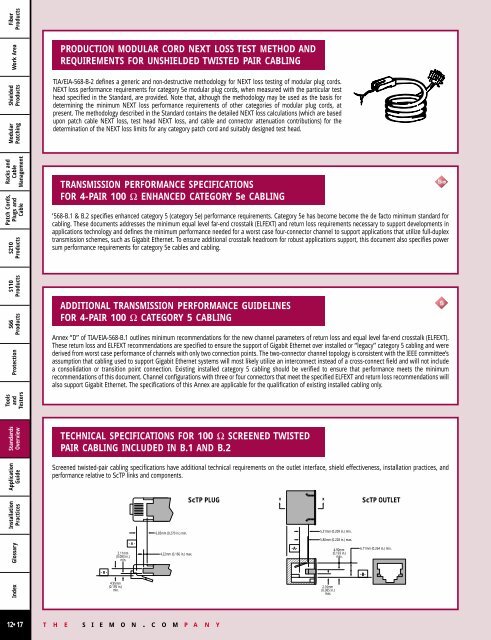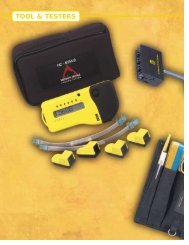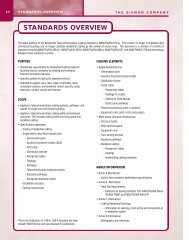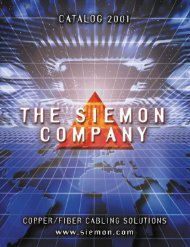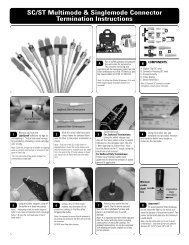fiber products
fiber products
fiber products
Create successful ePaper yourself
Turn your PDF publications into a flip-book with our unique Google optimized e-Paper software.
Work Area<br />
Shielded<br />
Products<br />
Tools<br />
and<br />
Testers<br />
Fiber<br />
Products<br />
Modular<br />
Patching<br />
PRODUCTION MODULAR CORD NEXT LOSS TEST METHOD AND<br />
REQUIREMENTS FOR UNSHIELDED TWISTED PAIR CABLING<br />
TIA/EIA-568-B-2 defines a generic and non-destructive methodology for NEXT loss testing of modular plug cords.<br />
NEXT loss performance requirements for category 5e modular plug cords, when measured with the particular test<br />
head specified in the Standard, are provided. Note that, although the methodology may be used as the basis for<br />
determining the minimum NEXT loss performance requirements of other categories of modular plug cords, at<br />
present. The methodology described in the Standard contains the detailed NEXT loss calculations (which are based<br />
upon patch cable NEXT loss, test head NEXT loss, and cable and connector attenuation contributions) for the<br />
determination of the NEXT loss limits for any category patch cord and suitably designed test head.<br />
Racks and<br />
Cable<br />
Management<br />
Patch Cords,<br />
Plugs and<br />
Cable<br />
S210<br />
Products<br />
TRANSMISSION PERFORMANCE SPECIFICATIONS<br />
FOR 4-PAIR 100 Ω ENHANCED CATEGORY 5e CABLING<br />
’568-B.1 & B.2 specifies enhanced category 5 (category 5e) performance requirements. Category 5e has become become the de facto minimum standard for<br />
cabling. These documents addresses the minimum equal level far-end crosstalk (ELFEXT) and return loss requirements necessary to support developments in<br />
applications technology and defines the minimum performance needed for a worst case four-connector channel to support applications that utilize full-duplex<br />
transmission schemes, such as Gigabit Ethernet. To ensure additional crosstalk headroom for robust applications support, this document also specifies power<br />
sum performance requirements for category 5e cables and cabling.<br />
S110<br />
Products<br />
S66<br />
Products<br />
Protection<br />
ADDITIONAL TRANSMISSION PERFORMANCE GUIDELINES<br />
FOR 4-PAIR 100 Ω CATEGORY 5 CABLING<br />
Annex “D” of TIA/EIA-568-B.1 outlines minimum recommendations for the new channel parameters of return loss and equal level far-end crosstalk (ELFEXT).<br />
These return loss and ELFEXT recommendations are specified to ensure the support of Gigabit Ethernet over installed or “legacy” category 5 cabling and were<br />
derived from worst case performance of channels with only two connection points. The two-connector channel topology is consistent with the IEEE committee’s<br />
assumption that cabling used to support Gigabit Ethernet systems will most likely utilize an interconnect instead of a cross-connect field and will not include<br />
a consolidation or transition point connection. Existing installed category 5 cabling should be verified to ensure that performance meets the minimum<br />
recommendations of this document. Channel configurations with three or four connectors that meet the specified ELFEXT and return loss recommendations will<br />
also support Gigabit Ethernet. The specifications of this Annex are applicable for the qualification of existing installed cabling only.<br />
Standards<br />
Overview<br />
Application<br />
Guide<br />
TECHNICAL SPECIFICATIONS FOR 100 Ω SCREENED TWISTED<br />
PAIR CABLING INCLUDED IN B.1 AND B.2<br />
Screened twisted-pair cabling specifications have additional technical requirements on the outlet interface, shield effectiveness, installation practices, and<br />
performance relative to ScTP links and components.<br />
Installation<br />
Practices<br />
6.85mm (0.270 in.) min.<br />
ScTP PLUG<br />
x<br />
x<br />
5.31mm (0.209 in.) min.<br />
5.80mm (0.228 in.) max.<br />
ScTP OUTLET<br />
Glossary<br />
2.11mm<br />
(0.083 in.)<br />
min.<br />
- A -<br />
4.22mm (0.166 in.) max.<br />
-A-<br />
4.90mm<br />
(0.193 in.)<br />
max.<br />
6.71mm (0.264 in.) min.<br />
- B -<br />
-B-<br />
Index<br />
4.95mm<br />
(0.195 in.)<br />
min.<br />
2.16mm<br />
(0.085 in.)<br />
max.<br />
12•17<br />
T H E S I E M O N . C O M P A N Y


